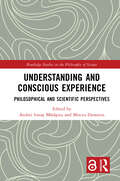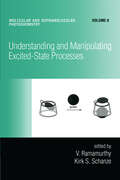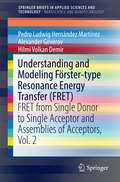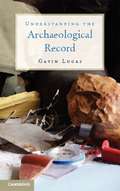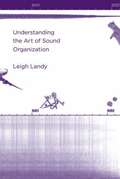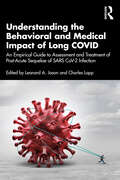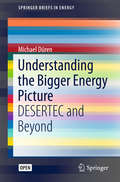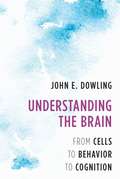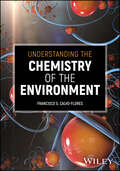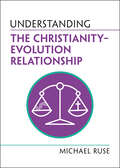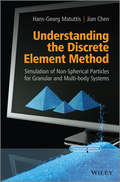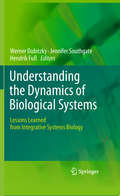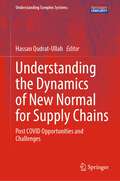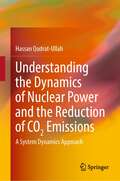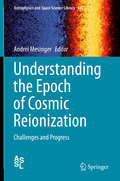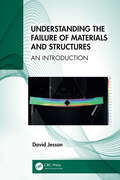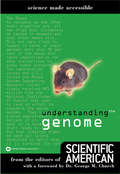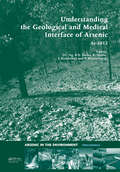- Table View
- List View
Understanding and Caring for People with Schizophrenia: Fifteen Clinical Cases
by Jeffrey A. Lieberman Gary Brucato Ragy R. GirgisThis book challenges professional and public misconceptions of schizophrenia as an illness with intractable symptoms and inexorable mental deterioration, educating clinicians and researchers on the effectiveness of treatment to change the course of or prevent the onset of illness. The authors illustrate such effectiveness through fifteen case studies examining psychosis in diverse clients. These case studies are divided into the three phases of the illness—prodromal/clinical high risk, first-episode, chronic, and treatment-refractory—with accompanying analyses of the causes, symptoms, interventions and treatments. By depicting patients at different clinical stages of the illness, with accompanying explanations of how they got to that point, what might have been done to avoid – or has been done to achieve – this outcome, the reader will gain an appreciation of the nature of the illness and for the therapeutic potential of currently available treatments. Readers will learn about the various clinical aspects of schizophrenia and treatment including diagnosis, prognosis, clinical presentation, suicide risk, cognitive deficits, stigma, medication management, and psychosocial interventions.
Understanding and Conscious Experience: Philosophical and Scientific Perspectives (Routledge Studies in the Philosophy of Science)
by Mircea Dumitru Andrei Ionuț MărăşoiuThis volume explores how understanding relates to conscious experience. In doing so, it builds bridges between different philosophical disciplines and provides a metaphysically robust characterization of understanding, both in and beyond science.The past two decades have witnessed growing interest from epistemologists, philosophers of science, philosophers of mind and ethicists in the nature and value of intellectual understanding. This volume features original essays on understanding and the phenomenal experiences that underlie it. The chapters are divided into three thematic sections. Part 1 provides theoretical characterizations of understanding, including Henk de Regt’s defense of a contextual theory of scientific understanding and a debate on whether scientific inference and explanatory power are necessary or central features of understanding. Part 2 explores how conscious experience and understanding are related. The chapters articulate a phenomenal theory of understanding and address themes that are connected to understanding, including awareness, transformative experiences and exemplification. Finally, Part 3 is devoted to domain-specific inquiries about understanding, such as logical proofs, particle physics and moral understanding.Understanding and Conscious Experience will be of interest to scholars and advanced students working in the philosophy of science, epistemology, philosophy of mind, ethics and phenomenology.
Understanding and Managing Threats to the Environment in South Eastern Europe
by Charles B. Fields Gorazd Meško Dejana DimitrijevićThis volume presents reflections on a variety of environmental issues in South-Eastern Europe from diverse contemporary scientific disciplines. The contributions address many crucial issues including national environmental policies, economic instruments for preventing crimes against the environment, international waste trafficking, threats to air, water and soil due to mining, management of dump areas, environment protection and food safety from a perspective of public health. The book will be a useful resource for researchers, developers and decision makers interested in the stability and sustainable development of the South-Eastern European countries.
Understanding and Manipulating Excited-State Processes (Molecular and Supramolecular Photochemistry)
by V. Ramamurthy Kirk S. SchanzeA state-of-the-art review of original research, this book includes discussions of intramolecular photoadditoin of nucleophiles, electrophiles, and radical species to the activated aromatic ring; new methods for regio-, anantio-, and diastereoselective photooxygenations involving singlet oxygen mechanisms; and applications of microreactors for photo
Understanding and Modeling Förster-type Resonance Energy Transfer (FRET): FRET from Single Donor to Single Acceptor and Assemblies of Acceptors, Vol. 2
by Alexander Govorov Pedro Ludwig Hernández Martínez Hilmi Volkan DemirThis Brief presents a historical overview of the Förster-type nonradiative energy transfer and a compilation of important progress in FRET research, starting from Förster until today, along with a summary of the current state-of-the-art. Here the objective is to provide the reader with a complete account of important milestones in FRET studies and FRET applications as well as a picture of the current status.
Understanding and Modeling Förster-type Resonance Energy Transfer (FRET): FRET-Applications, Vol. 3
by Alexander Govorov Pedro Ludwig Hernández Martínez Hilmi Volkan DemirThis Brief presents a historical overview of the Förster-type nonradiative energy transfer and a compilation of important progress in FRET research, starting from Förster until today, along with a summary of the current state-of-the-art. Here the objective is to provide the reader with a complete account of important milestones in FRET studies and FRET applications as well as a picture of the current status.
Understanding and Modeling Förster-type Resonance Energy Transfer (FRET): Introduction to FRET, Vol. 1
by Alexander Govorov Pedro Ludwig Hernández Martínez Hilmi Volkan DemirThis Brief presents a historical overview of the Förster-type nonradiative energy transfer and a compilation of important progress in FRET research, starting from Förster until today, along with a summary of the current state-of-the-art. Here the objective is to provide the reader with a complete account of important milestones in FRET studies and FRET applications as well as a picture of the current status.
Understanding the Archaeological Record
by Gavin LucasThis book explores the diverse understandings of the archaeological record in both historical and contemporary perspective, while also serving as a guide to reassessing current views. Gavin Lucas argues that archaeological theory has become both too fragmented and disconnected from the particular nature of archaeological evidence. The book examines three ways of understanding the archaeological record - as historical sources, through formation theory and as material culture - then reveals ways to connect these three domains through a reconsideration of archaeological entities and archaeological practice. Ultimately, Lucas calls for a rethinking of the nature of the archaeological record and the kind of history and narratives written from it.
Understanding the Art of Sound Organization
by Leigh LandyThe first work to propose a comprehensive musicological framework to study sound-based music, a rapidly developing body of work that includes electro-acoustic art music, turntable composition, and acoustic and digital sound installations.
Understanding the Behavioral and Medical Impact of Long COVID: An Empirical Guide to Assessment and Treatment of Post-Acute Sequelae of SARS CoV-2 Infection
by Leonard A. Jason and Charles LappUnderstanding the Behavioral and Medical Impact of Long COVID serves to expand the research around the illness in order to enable health care researchers and practitioners to address the questions that are imperative to individuals suffering from this condition. Through its multi-faceted approach, the book puts forth a maturation of research and interventions that are theoretically sound, empirically valid, innovative, and creative in the Long COVID area. As a scholarly and scientific compilation of Long COVID symptoms and related disorders, this book offers unparalleled insight into the critical developments across medical areas treating this illness. It helps to fill the space that the pandemic had created for knowledge of the condition, and contributes to the emerging emphasis on translational research blending the social sciences and biological fields. By putting forth the most optimal medical care practices in the treatment of complex Long COVID symptoms, this practical anthology will serve as a guide for practicing clinicians in assessment as well as treatment. It will also benefit researchers aiming to gain more understanding of Long COVID through its discussion around the critical developments in other medical areas treating the condition, and paves the way for the collaboration and future research needed to best support the global effort to mitigate the effects of this illness. This book will be essential reading for academics, practitioners, and researchers. It will appeal to individuals engaging with the fields of medicine, public policy, psychology, and for researchers looking to gain clarity about our current understanding of Long COVID. It will further be of interest to public/government agencies, nonprofit organizations, and the general public wanting to gain more information about these ambiguous and evasive symptoms.
Understanding the Bigger Energy Picture: DESERTEC and Beyond (SpringerBriefs in Energy)
by Michael DürenThis book is open access under a CC BY 4.0 license.This book focuses on the global cycles of energy, water and carbon, which are not only the essentials of our main energy carriers, the fossil fuels, but are also the building blocks of life. The book offers an overview of the basic scientific facts and relationships that are needed to understand today’s energy generation and use, how they relate to global climate, the water cycle and other resources, and the complexities of energy policy. Building on the work of the Desertec project, it presents the main technological options that we will have in a world after the “Energiewende” and presents the possible future solutions for a sustainable world. The book is written in an engaging, descriptive style that can be understood by those without specific knowledge of science or economics and allows readers to form their own conclusions. Controversy rages over energy problems, climate change and their possible solutions. Expressions like “climate deniers”, “renaissance of nuclear energy”, “stop the war on coal”, and “Energiewende now” represent a diversity of opinions that divide our society and political leaders. This book shows the reader the whole energy picture and how it is part of the wider global problems of overpopulation and uncontrolled economies in a world of limited resources.
Understanding the Biological Basis of Behavior: Developing Evidence-Based Interventions for Clinical, Counseling and School Psychologists
by Rik Carl D’Amato Andrew S. Davis Elizabeth M. Power Eleazar Cruz EusebioThis book is an introduction to the biological basis of behavior, broadly defined, with practical applications for higher education programs that focus on advances in neuroscience. It has a special focus on training practitioners based on American Psychological Association (APA) health service psychology guidelines. It reviews and digests information for clinical, counseling, and school psychologists serving clients of all ages in a variety of settings, such as schools, hospitals, and clinics. Content for all developmental stages, including birth to geriatric practices are highlighted. Some unique features of this book include:The integration of neuropsychological and theoretical foundations for clinical practice.Comprehensive consideration of projective, objective, and interviewing measures.Recent research in neuroimaging as it relates to clinical practice.Psychopharmacology and its effect within the neurosciences.Assessment for intervention in clinical, counseling, school, and neuropsychology.The use of research to guide neuropsychologically-based clinical practice.Eastern and western approaches to integration and case conceptualization.Interventions driven by brain-based scientific understanding.A variety of neuropsychological cases and report styles to improve practiceThe enduring contribution of psychology into modern times will remain contingent on practitioners' commitment to ethically-based, empirically-focused, evidence-based practice; continuing education; and scientific discovery. This book will help health service psychologists and counselors to meet the needs of an increasingly diverse population by providing cutting-edge, evidence-based, ecologically valid neuropsychological interventions currently lacking within the field. Cultural considerations are provided within each chapter, which is especially important given societal inequity that continues to persist within our world. Implications for the COVID-19 pandemic are also discussed in light of neuroscientific advances in medicine.
Understanding the Brain: From Cells To Behavior To Cognition
by John E. DowlingAn examination of what makes us human and unique among all creatures—our brains. No reader curious about our “little grey cells” will want to pass up Harvard neuroscientist John E. Dowling’s brief introduction to the brain. In this up-to-date revision of his 1998 book Creating Mind, Dowling conveys the essence and vitality of the field of neuroscience—examining the progress we’ve made in understanding how brains work, and shedding light on discoveries having to do with aging, mental illness, and brain health. The first half of the book provides the nuts-and-bolts necessary for an up-to-date understanding of the brain. Covering the general organization of the brain, early chapters explain how cells communicate with one another to enable us to experience the world. The rest of the book touches on higher-level concepts such as vision, perception, language, memory, emotion, and consciousness. Beautifully illustrated and lucidly written, this introduction elegantly reveals the beauty of the organ that makes us uniquely human.
Understanding the Chemistry of the Environment
by Francisco G. Calvo-FloresUnderstand the properties and consequences of chemical pollutants Environmental chemistry is the field of study which focuses on chemical species, natural or man-made, and their impact on the atmosphere, water, and soils. It’s a growing area of research and technological development, increasingly prominent in university chemistry curricula. There is more demand than ever for a strong textbook overview of this thriving interdisciplinary subject and its myriad applications. Understanding the Chemistry of the Environment meets this demand with an exploration of the chemical aspects of pollution and its consequences. It offers a clear explanation of the relationship between chemical structure, physiochemical properties of natural and anthropogenic substances, and environmental impact. Drawing upon advances in chemistry, biochemistry, physics, engineering, toxicology, and more, it is a must-own for students and researchers in environmental chemistry. Understanding the Chemistry of the Environment readers will also find: Overview of major chemical pollutants and their ecotoxicological effects Understanding the Chemistry of the Environment is ideal for undergraduate students in environmental chemistry courses, as well as graduate students in need of a reference work on environmental chemistry.
Understanding the Christianity–Evolution Relationship (Understanding Life)
by Michael RuseThe relationship between science and religion is a topic that runs rife with misconceptions, misunderstandings and debates. Are science and religion always in conflict? Is Darwin's theory of evolution through natural selection atheistic? How does history shape current debates around science and religion? This book explores these questions in a neutral and balanced way, focusing on the Christianity-evolution relationship. It shows that two paradigms – the world as an organism and the world as a machine – have critically informed and guided the discussions. The author uses his deep understanding of the history and philosophy of science, particularly Darwinian evolutionary theory and its controversies through the past 150 years, to bring fresh ideas to the debate and to wider discussions such as environmental issues and hate. Understanding the Christianity-Evolution Relationship provides a lively and informative analysis and lays out multiple views so that readers can make their own judgements to increase their understanding.
Understanding the Connections Between Coastal Waters and Ocean Ecosystem Services and Human Health: Workshop Summary
by Rose Marie Martinez"Understanding the Connections Between Coastal Waters and Ocean Ecosystem Services and Human Health" discusses the connection of ecosystem services and human health. This report looks at the state of the science of the role of oceans in ensuring human health and identifies gaps and opportunities for future research. The report summarizes a workshop convened by the Institute of Medicine's Roundtable on Environmental Health Sciences, Research, and Medicine. Participants discussed coastal waters and ocean ecosystem services in the United States in an effort to understand impacts on human health. "Understanding the Connections Between Coastal Waters and Ocean Ecosystem Services and Human Health" focuses on key linkages by discussing the ecosystem services provided by coastal waterways and oceans that are essential for human health and well-being; examining the major stressors that affect the ability of coastal waterways and ocean systems to provide essential services; and considering key factors that can enhance the resiliency of these systems.
Understanding the Discrete Element Method: Simulation of Non-Spherical Particles for Granular and Multi-body Systems
by Jian Chen Hans-Georg MatuttisGives readers a more thorough understanding of DEM and equips researchers for independent work and an ability to judge methods related to simulation of polygonal particles Introduces DEM from the fundamental concepts (theoretical mechanics and solidstate physics), with 2D and 3D simulation methods for polygonal particles Provides the fundamentals of coding discrete element method (DEM) requiring little advance knowledge of granular matter or numerical simulation Highlights the numerical tricks and pitfalls that are usually only realized after years of experience, with relevant simple experiments as applications Presents a logical approach starting withthe mechanical and physical bases,followed by a description of the techniques and finally their applications Written by a key author presenting ideas on how to model the dynamics of angular particles using polygons and polyhedral Accompanying website includes MATLAB-Programs providing the simulation code for two-dimensional polygons Recommended for researchers and graduate students who deal with particle models in areas such as fluid dynamics, multi-body engineering, finite-element methods, the geosciences, and multi-scale physics.
Understanding the Dynamics of Biological Systems
by Hendrik Fuß Werner Dubitzky Jennifer SouthgateThis book is intended as a communication platform to bridge the cultural, conceptual, and technological gap among the key systems biology disciplines of biology, mathematics, and information technology. To support this goal, contributors were asked to adopts an approach that appeals to audiences from different backgrounds.
Understanding the Dynamics of New Normal for Supply Chains: Post COVID Opportunities and Challenges (Understanding Complex Systems)
by Hassan Qudrat-UllahThis book provides research results and shares experiences in the area of supply chain management. It addresses topics such as risk reduction of lesser marginal profits, disrupted supply chain management, and potential points of business failure. This book explores the “new normal” of the business supply chain. The didactic approach informs global enterprises on how to deal with the most significant issues in the current supply chain management. The book shows an in-depth analysis of post-COVID opportunities and challenges and acts as an initiative for readers to understand the risks, opportunities, and concerns resulting from the pandemic situation and is a key driver for business management among industry professionals and enterprises. Readers will learn new insights and procedures to better manage multitier supply chains, predictability, and estimation of binding capacity. The book details modeling and technology-based customer demand and response management solutions. New techniques, methods, and perspectives dealing with the estimation, acceleration or deceleration, and flexibility of logistics capacity are particularly emphasized throughout the manuscript. Real-world cases dealing with various aspects of the new normal for supply chains are analyzed. The book is useful for industry professionals and enterprise firms in business management to effectively understand risks, opportunities, and concerning the pandemic situation.
Understanding the Dynamics of Nuclear Power and the Reduction of CO2 Emissions: A System Dynamics Approach
by Hassan Qudrat-UllahThis books explains a strategy that a country can meet its CO2 emission reduction targets (e.g., as are in Paris Agreement) with a dominant share of nuclear power with a balanced energy supply mix. The book starts with an introduction to the subject of energy policy, mechanisms, and CO2 emissions, and the complexity of the CO2 reduction goal. It introduces the system dynamics approach as a solution modeling approach for dealing with the complexity of CO2 reducing policies and mechanisms. The book presents the dynamic model and its key parameters and then elaborates the structural and behavioral validity of the dynamic model. The book gives an intensive review to do that comparative analysis involving China, India, Saudi Arabia, UAE, and Pakistan. The last half of the book focuses on the case in Pakistan. The author reviews Pakistan’s Intended Nationally Determined Contribution and other key sources from Pakistan’s Ministry of Energy and related institutions. Using Pakistan’s case data, the author applies the system dynamics modeling approach whereby a dynamic model, capable of representing the important interactions among various sectors of the electricity supply sector of Pakistan. This book is intended to be of use to policymakers, managers and practitioners, teachers, researchers, and students of design and assessment of policymaking for the complex, dynamic energy systems
Understanding the Enrichment of Heavy Elements by the Chemodynamical Evolution Models of Dwarf Galaxies (Springer Theses)
by Yutaka HiraiThis book addresses the mechanism of enrichment of heavy elements in galaxies, a long standing problem in astronomy. It mainly focuses on explaining the origin of heavy elements by performing state-of-the-art, high-resolution hydrodynamic simulations of dwarf galaxies. In this book, the author successfully develops a model of galactic chemodynamical evolution by means of which the neutron star mergers can be used to explain the observed abundance pattern of the heavy elements synthesized by the rapid neutron capture process, such as europium, gold, and uranium in the Local Group dwarf galaxies. The book argues that heavy elements are significant indicators of the evolutionary history of the early galaxies, and presents theoretical findings that open new avenues to understanding the formation and evolution of galaxies based on the abundance of heavy elements in metal-poor stars.
Understanding the Epoch of Cosmic Reionization
by Andrei MesingerThe dawn of the first stars, galaxies and black holes signaled a fundamental milestone in our Universe's evolution: the Epoch of Reionization. The light from these galactic ancestors began spreading out, ionizing virtually every atom in existence. Our Universe transitioned from darkness to light, from cold to hot, from simple and boring to the wondrous cosmic zoo we see around us today. Despite its importance, observations of reionization have been few, and their interpretation has been highly controversial. Fortunately, this is rapidly changing. We will soon enter the "Big Data" era of this mysterious epoch, driven by an upcoming wave of observations with state-of-the-art telescopes as well as new sophisticated analysis tools. The aim of this volume is to summarize the current status and future outlook of the reionization field. We bring together leading experts in many sub-disciplines, highlighting the measurements that will illuminate our understanding of reionization and the cosmic dawn: (i) 21cm interferometry; (ii) high-redshift quasar spectra; (iii) high-redshift galaxy surveys; (iv) primary and secondary anisotropies of the Cosmic Microwave Background; (v) high-resolution studies of the metal content of early galaxies. We seek a roadmap to interpreting the wealth of upcoming observations. What is the best use of limited observational resources? How do we develop theoretical tools tailored for each observation? Ultimately, what will we learn about the epoch of reionization and our galactic ancestors?
Understanding the Failure of Materials and Structures: An Introduction
by David JessonUnderstanding the Failure of Materials and Structures introduces practical aspects of mechanical characterisation of materials and structures. It gives those with little or no prior experience insight into the process of developing everyday products, issues behind some high-profile failures, and tools to begin planning a programme of research.Written in an easily accessible manner, the work discusses fundamentals of the physical world, highlighting the range of materials used and varied applications, and offers a brief history of materials development. It covers the role of materials structure in controlling materials properties and describes mechanical properties, such as stress, strain, stiffness, fracture, and fatigue. The book also features information on various modes of testing and strain measurement. It provides some discussion on topics that go beyond well-behaved test coupons, with thoughts on biomechanics, megastructures, and testing for applications in extreme environments. Finally, it covers how materials fail and the future of physical testing.With minimal theory and mathematics, this work presents the fundamentals of mechanical characterisation of materials and structures in a manner accessible to the novice materials investigator and the layperson interested in the science behind materials engineered for use in common and advanced products.
Understanding the Genome
by Editors of Scientific AmericanA guide to understanding the genome and the possibilities of this knowledge.
Understanding the Geological and Medical Interface of Arsenic - As 2012: Proceedings of the 4th International Congress on Arsenic in the Environment, 22-27 July 2012, Cairns, Australia (Arsenic in the Environment - Proceedings)
by Jochen Bundschuh Prosun Bhattacharya Ravi Naidu Jack C. Ng Barry N. NollerThe congress "Arsenic in the Environment" offers an international, multi- and interdisciplinary discussion platform for arsenic research aimed at practical solutions of problems with considerable social impact, as well as focusing on cutting edge and breakthrough research in physical, chemical, toxicological, medical and other specific issues on ar

